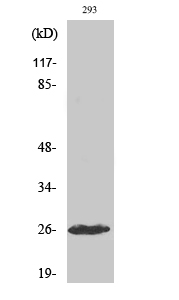Cleaved-C1r LC (I464) Polyclonal Antibody
- SPECIFICATION
- CITATIONS
- PROTOCOLS
- BACKGROUND

Application
| WB |
|---|---|
| Primary Accession | P00736 |
| Reactivity | Human |
| Host | Rabbit |
| Clonality | Polyclonal |
| Calculated MW | 80119 Da |
| Gene ID | 715 |
|---|---|
| Other Names | C1R; Complement C1r subcomponent; Complement component 1 subcomponent r |
| Dilution | WB~~Western Blot: 1/500 - 1/2000. ELISA: 1/20000. Not yet tested in other applications. |
| Format | Liquid in PBS containing 50% glycerol, 0.5% BSA and 0.09% (W/V) sodium azide. |
| Storage Conditions | -20℃ |
| Name | C1R {ECO:0000303|PubMed:3021205, ECO:0000312|HGNC:HGNC:1246} |
|---|---|
| Function | Serine protease component of the complement C1 complex, a multiprotein complex that initiates the classical pathway of the complement system, a cascade of proteins that leads to phagocytosis and breakdown of pathogens and signaling that strengthens the adaptive immune system (PubMed:17996945, PubMed:19473974, PubMed:29449492). C1R catalyzes the first enzymatic step in the classical complement pathway: it is activated by the C1Q subcomplex of the C1 complex, which associates with IgG or IgM immunoglobulins complexed with antigens to form antigen-antibody complexes on the surface of pathogens (PubMed:29449492, PubMed:34155115). Immunoglobulin-binding promotes the autocatalytic cleavage and activation of C1R (PubMed:11445589, PubMed:11673533, PubMed:17996945, PubMed:20178990, PubMed:6254570, PubMed:6271784). Activated C1R then cleaves and activates C1S, the second protease of the classical complement pathway (PubMed:11445589, PubMed:11673533, PubMed:6271784). It is unclear if C1R activates C1S within single, strained C1 complexes or between neighboring C1 complexes on surfaces (PubMed:28104818, PubMed:29311313, PubMed:29449492). |
| Cellular Location | Secreted. Cell surface. Note=Recruited to the surface of pathogens by the C1Q subcomplex. |

Thousands of laboratories across the world have published research that depended on the performance of antibodies from Abcepta to advance their research. Check out links to articles that cite our products in major peer-reviewed journals, organized by research category.
info@abcepta.com, and receive a free "I Love Antibodies" mug.
Provided below are standard protocols that you may find useful for product applications.
Background
C1r B chain is a serine protease that combines with C1q and C1s to form C1, the first component of the classical pathway of the complement system.
If you have used an Abcepta product and would like to share how it has performed, please click on the "Submit Review" button and provide the requested information. Our staff will examine and post your review and contact you if needed.
If you have any additional inquiries please email technical services at tech@abcepta.com.













 Foundational characteristics of cancer include proliferation, angiogenesis, migration, evasion of apoptosis, and cellular immortality. Find key markers for these cellular processes and antibodies to detect them.
Foundational characteristics of cancer include proliferation, angiogenesis, migration, evasion of apoptosis, and cellular immortality. Find key markers for these cellular processes and antibodies to detect them. The SUMOplot™ Analysis Program predicts and scores sumoylation sites in your protein. SUMOylation is a post-translational modification involved in various cellular processes, such as nuclear-cytosolic transport, transcriptional regulation, apoptosis, protein stability, response to stress, and progression through the cell cycle.
The SUMOplot™ Analysis Program predicts and scores sumoylation sites in your protein. SUMOylation is a post-translational modification involved in various cellular processes, such as nuclear-cytosolic transport, transcriptional regulation, apoptosis, protein stability, response to stress, and progression through the cell cycle. The Autophagy Receptor Motif Plotter predicts and scores autophagy receptor binding sites in your protein. Identifying proteins connected to this pathway is critical to understanding the role of autophagy in physiological as well as pathological processes such as development, differentiation, neurodegenerative diseases, stress, infection, and cancer.
The Autophagy Receptor Motif Plotter predicts and scores autophagy receptor binding sites in your protein. Identifying proteins connected to this pathway is critical to understanding the role of autophagy in physiological as well as pathological processes such as development, differentiation, neurodegenerative diseases, stress, infection, and cancer.


